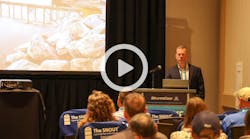A Weapon Against Drought?
According to an abstract published by the Cognis Corporation of Cincinnati, OH, and Duesseldorf, Germany, the company’s Terra-Control Soil Stabilizer, a polyvinyl acetate-based formulation, forms a three-dimensional membrane structure that holds seeds and soil in place while allowing water and oxygen penetration (see the article “Environmentally Favorable Erosion Control With a Polyvinyl Acetate-Based Formulation“).
Various tests and field trials in the US, Europe, Australia, Malaysia, and Africa revealed that Terra-Control improved soil structure by increasing water and air permeability, the stability of soil aggregates, and infiltration/drainage. The product was also shown to reduce water demand; test plots of lettuce seedlings that received applications of Terra-Control yielded identical plant biomasses to the control groups while reducing water demand between 5% and 50%. Even in Algeria’s sandy soil, with temperatures of 35-0C (95-10F), soil saturation was improved 30-0%.
Other trials with the product revealed that seeds germinated two to five days earlier and that grasses had a higher germination rate (more than 20%). The product also helped retain soil during strong precipitation and despite wind erosion.
With such results, it’s clear that chemistry is developing an arsenal against drought.
The abstract also states that no toxic effects against plants, soil bacteria, and fungi are known and that acute toxicity of the primary degradation products of the ingredients is accordingly very low. Toxicity to fish (golden orfe) and Daphina magna (acute, 8 hours) rated an LC50 > 100 mg/l; toxicity to bacteria (Pseudomonas putida) for the same period rated LC0 >10,000 mg/l.
An Enzyme You Can Drive a Truck Over
Nashville, TN’s Cypher USA, a subsidiary of Cypher International, produces a similar product, EarthZyme. The multienzyme product was developed as an aid for the workability, mixability, binding, and compaction of soil, improving stability in road, dam, and landing-strip construction. The biodegradable product is suspended in water, and its cationic action binds soil particles together.
When used on unsealed roads, EarthZyme creates a strong, dense pavement. Trials show that when EarthZyme is used, unsealed-road maintenance can be reduced significantly; less dusting occurs, and gravel might last up to two years longer before resheeting is required.
If used on subgrade materials, EarthZyme shows its greatest effect on clay, a soil type that can bond itself into a concretelike material. (Because of the properties of the three main soil types, most chemical intervention products work much better on clay than on sandy or loam soils.) When applied to natural subgrades, EarthZyme has produced California Bearing Ratio increases of 30-0%; -5% increases in density can also be achieved, and reductions in both optimum moisture content and plasticity index can occur. Such improvements in soil strength can reduce the need for the purchase and transport of base gravels. EarthZyme can increase the physical characteristics of lower-quality base-course material with too high a clay content, bringing it to a suitable seal standard.
With so many products available that appear to be environmentally friendly, that can decrease erosion while also decreasing the use of other materials such as gravel, and that might aid in allowing arid soil to flourish and bloom, it’s evident that chemical intervention is a process worth considering.


